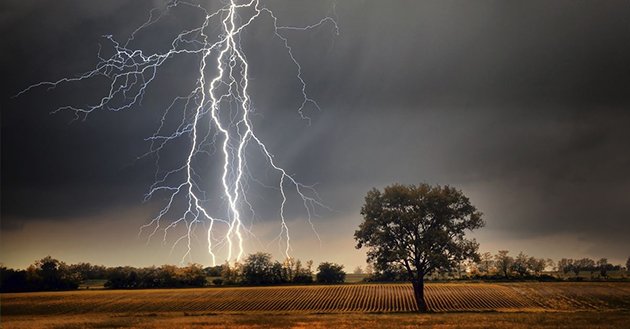Thought You Are Safe Indoors – Practical Tips To Survive Severe Storms

Glow-in-the-Dark Flashlight
Glow-in-the-dark tape makes a flashlight easy to find when the power goes out. Adhesive-backed tape holds its radiance for hours after exposure to light. Find it at home centers or online.
Lightning: Don’t Get Struck Indoors
Your home is probably the safest place to be in an electrical storm. But here’s a safety tip you may not know. Lightning can still get to you through the conductive paths in your house; that means your wiring, your plumbing and water. Talking on a corded phone, taking a shower or bath, working on your desktop computer or handling power tools during an electrical storm isn’t much safer than standing outside. It’s best to stay away from all water and appliances until the storm passes.
………..
Stay Out of Gushing Floodwater
Six inches of floodwater doesn’t look dangerous. But if it’s moving fast enough, it’s enough to sweep you off your feet and carry you into the hereafter. Rushing water also erodes roads and walkways, creating drop-offs that you can’t see under the torrent. A long pole, stick or pipe lets you probe for drop-offs and might help you stay on your feet. Still, the smartest move is to stay out of flowing water.
………..
Flooded Basement? Turn Off the Gas
Floodwater and floating junk can lead to damaged gas lines and malfunctioning gas controls. Leaked gas then bubbles up through the water, giving your basement an explosive atmosphere on top of the flood. And the smell of gas may be masked by other floodwater odors. So call the utility company to shut off your gas even if you don’t smell it. If you do smell gas, get out of the house before you make the call.
………..
Turn Your Car Into a Generator
A power inverter, which turns DC current from your car into AC current for electric gadgets, is the next best thing to a generator when it comes to surviving a blackout. An inverter to power a tablet or laptop will cost you about $25, but there are much bigger models ($100 and up) that can run power tools and appliances.
……….
Fill the Tub
If you live in a hurricane-prone area or have frequent power outages, you can store fresh water in a giant plastic container in your bathtub. The collapsed containers are small and easy to store between emergencies. …………..
…………
Ice Saves Money
A couple of days without power can cost you a few hundred bucks as food spoils in fridges and freezers. You could try to buy a few bags of ice (along with everyone else) after the power goes out. But here’s a better idea: Fill locking freezer bags with water and keep them in the freezer. During a blackout, they’ll help the freezer stay cold longer. Or you can transfer them to the fridge or a cooler. When they thaw, you’ve got drinking water.
…………
Patch a Small Hole
Minor roof damage can lead to major water damage inside your home. But if you keep a few simple materials on hand, you can seal most roof injuries in just a few minutes. A section of flashing is the perfect patch for smaller holes—often caused by blown-down tree branches. Don’t forget to caulk around the hole. Special roof sealant is best, but any type of caulk is better than nothing.
………….
Flush with a Bucket
Even if a power outage stops your well pump or the city water supply, you can still flush the toilet. Dump a couple gallons into the bowl or fill the toilet tank. This works just as well as the usual flush, but won’t refill the bowl.
………..
Related Articles
- How To Survive A Power Blackout
- Hurricane Evacuation – This Is Suzi’s Story
- Absolutely Must Haves For Urban Survival
Read the full article here: Click Here
Article source: Family Handyman
Image source: Salem Web Network









